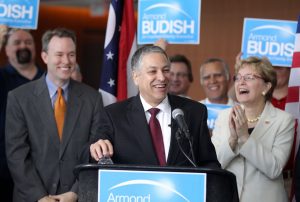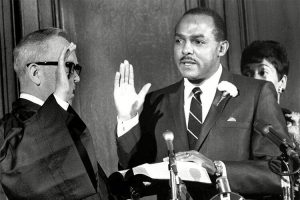CLEVELAND — On the day after his life changed forever, Cleveland’s next mayor got a glimpse of his future.
As well-wishers paraded by his lunch table at the Diner on 55th, one stopped to offer a kindly hug and quiet prayer. The Rev. Stephen Kosinski, a priest at St. Stanislaus Church in the Fleet Avenue neighborhood, had never met Justin Bibb, but knew what had just happened to him.
“Bless you,” Father Kosinski said softly.
He’ll need it.
Not a whole lot in Bibb’s 34 years has prepared him for the task ahead. But that mattered not at all to nearly 63% of those who bothered to cast ballots in Cleveland’s mayoral election. To them, Bibb was tomorrow’s candidate. His opponent, the experienced Council President Kevin Kelley, was yesterday’s.
This had been clear since the Sept. 14 primary election, when Bibb ran first and beat down former Mayor Dennis Kucinich in West Park, the city’s biggest voting neighborhood. Cleveland politics is changing, probably for the better.
Kelley and his campaign team never figured it out. Team Bibb outhustled and outthought their opponent at every turn. The result was an epic beatdown, maybe the most remarkable win I’ve seen in nearly 52 years of paying attention to these things. At least the equal of Michael White’s dramatic Cleveland mayoral win 32 years ago. (Note: White also saw this coming).
Bibb is smart and personable. On paper, Kelley was much more qualified. But Bibb and his campaign’s two strategists, Ryan Puente and Bill Burges, took the risk that white voters, especially young ones, might be willing to look past the city’s tired old history of racial politics and support someone who promised change.
Maybe they were lucky. Maybe they were visionaries. What we know for certain is they were right. On Nov. 2, Clevelanders who bothered to participate in the democratic process voted overwhelmingly to break from the past. Kelley got beat in parts of the West Side he would have won in a landslide if he’d been running 40 years ago against a Black opponent.
It was no better for Kelley east of the Cuyahoga, where the council president’s supporters thought Bibb’s lack of support from Black councilmen would limit the size of his win. It should have been clear that support for Bibb from nearly 80 Black ministers mattered infinitely more. It was another mind-numbing miscalculation, as Bibb crushed Kelley everywhere on the East Side, especially in the vote-rich southeast part of Cleveland, where Bibb’s defeated mayoral primary election rival Zack Reed worked indefatigably on the winner’s behalf.
But Bibb had an unwitting ally in all this. For months, Mayor Frank Jackson delayed announcing whether he would run for a fifth term, leaving in the lurch Kelley and another potential candidate, Councilman Blaine Griffin. While Kelley waited, Bibb campaigned tirelessly,
Back then, few took Bibb seriously. And some who later supported him dismissed Bibb as a lightweight.
“I was running by myself for five months,” said Bibb, with genuine astonishment. “I might not have won without that.”
Kelley got into politics for the right reasons. If he’s bitter about how Jackson hurt him, he has reason to be. The mayor’s dithering was selfish and wrong.
Bibb will be the least experienced mayor in the city’s history. To that, a huge majority of the voters collectively replied, “So what?”
So now it’s time to shelve concerns about his resume and youth, time to give him a chance to govern with creativity. I’m not sure the people who didn’t see this coming deserve a seat at the table, though Bibb will probably graciously give them one, anyway.
Sure, Bibb’s inexperience makes this a bit of a “hold your breath” moment. But those who worry Bibb will surround himself with other newcomers are probably mistaken.
“We will hire smart people, young and old, with diverse sets of experiences,” he told me. “And I am going to be thoughtful and deliberative about the entire process.”
Bibb’s election represents a historic change in the way people in the city vote. It doesn’t mean he’ll be a great mayor. It does mean he did a great thing.
Brent Larkin was The Plain Dealer’s editorial director from 1991 until his retirement in 2009.








